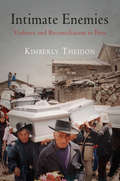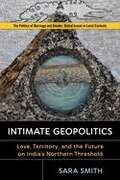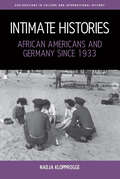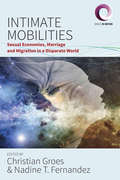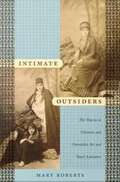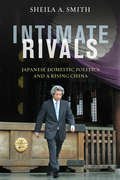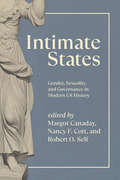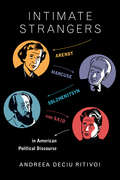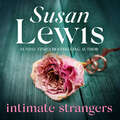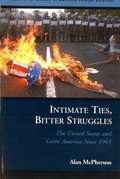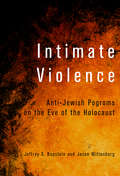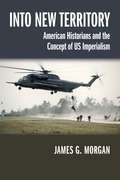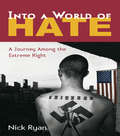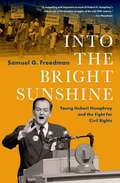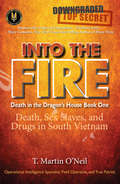- Table View
- List View
Intimate Enemies: Violence and Reconciliation in Peru (Pennsylvania Studies in Human Rights)
by Kimberly TheidonIn the aftermath of a civil war, former enemies are left living side by side—and often the enemy is a son-in-law, a godfather, an old schoolmate, or the community that lies just across the valley. Though the internal conflict in Peru at the end of the twentieth century was incited and organized by insurgent Senderistas, the violence and destruction were carried out not only by Peruvian armed forces but also by civilians. In the wake of war, any given Peruvian community may consist of ex-Senderistas, current sympathizers, widows, orphans, army veterans—a volatile social landscape. These survivors, though fully aware of the potential danger posed by their neighbors, must nonetheless endeavor to live and labor alongside their intimate enemies.Drawing on years of research with communities in the highlands of Ayacucho, Kimberly Theidon explores how Peruvians are rebuilding both individual lives and collective existence following twenty years of armed conflict. Intimate Enemies recounts the stories and dialogues of Peruvian peasants and Theidon's own experiences to encompass the broad and varied range of conciliatory practices: customary law before and after the war, the practice of arrepentimiento (publicly confessing one's actions and requesting pardon from one's peers), a differentiation between forgiveness and reconciliation, and the importance of storytelling to make sense of the past and recreate moral order. The micropolitics of reconciliation in these communities present an example of postwar coexistence that deeply complicates the way we understand transitional justice, moral sensibilities, and social life in the aftermath of war. Any effort to understand postconflict reconstruction must be attuned to devastation as well as to human tenacity for life.
Intimate Geopolitics: Love, Territory, and the Future on India’s Northern Threshold (Politics of Marriage and Gender: Global Issues in Local Contexts)
by Sara SmithWinner of the 2021 Julian Minghi Distinguished Book Award from the American Association of Geographers 2021 Foreword Indies Finalist - Politics and Social Sciences Intimate Geopolitics begins with a love story set in the Himalayan region of Ladakh, in India’s Jammu and Kashmir State, but this is also a story about territory, and the ways that love, marriage, and young people are caught up in contemporary global processes. In Ladakh, children grow up to adopt a religious identity in part to be counted in the census, and to vote in elections. Religion, population, and voting blocs are implicitly tied to territorial sovereignty and marriage across religious boundaries becomes a geopolitical problem in an area that seeks to define insiders and outsiders in relation to borders and national identity. This book populates territory, a conventionally abstract rendering of space, with the stories of those who live through territorial struggle at marriage and birth ceremonies, in the kitchen and in the bazaar, in heartbreak and in joy. Intimate Geopolitics argues for the incorporation of the role of time–temporality–into our understanding of territory.
Intimate Histories: African Americans and Germany since 1933 (Explorations in Culture and International History #12)
by Nadja KlopproggeIntimate Histories focuses on intimate relations as sites of shared pasts connecting African American and German history in the years between 1933 and 1990. By tracing topics that include anti-miscegenation laws, forced sterilization, casual sexual encounters, marriage, and friendships, Intimate Histories broadens our understanding of African American–German relations during the so-called “century of extremes.”
Intimate Mobilities: Sexual Economies, Marriage and Migration in a Disparate World (Worlds in Motion #3)
by Christian Groes Nadine T. FernandezAs globalization and transnational encounters intensify, people’s mobility is increasingly conditioned by intimacy, ranging from love, desire, and sexual liaisons to broader family, kinship, and conjugal matters. This book explores the entanglement of mobility and intimacy in various configurations throughout the world. It argues that rather than being distinct and unrelated phenomena, intimacy-related mobilities constitute variations of cross-border movements shaped by and deeply entwined with issues of gender, kinship, race, and sexuality, as well as local and global powers and border restrictions in a disparate world.
Intimate Outsiders: The Harem in Ottoman and Orientalist Art and Travel Literature
by Mary RobertsUntil now, the notion of a cross-cultural dialogue has not figured in the analysis of harem paintings, largely because the Western fantasy of the harem has been seen as the archetype for Western appropriation of the Orient. In Intimate Outsiders, the art historian Mary Roberts brings to light a body of harem imagery that was created through a dynamic process of cultural exchange. Roberts focuses on images produced by nineteenth-century European artists and writers who were granted access to harems in the urban centers of Istanbul and Cairo. As invited guests, these Europeans were "intimate outsiders" within the women's quarters of elite Ottoman households. At the same time, elite Ottoman women were offered intimate access to European culture through their contact with these foreign travelers. Roberts draws on a range of sources, including paintings, photographs, and travelogues discovered in archives in Britain, Turkey, Egypt, and Denmark. She rethinks the influential harem works of the realist painter John Frederick Lewis, a British artist living in Cairo during the 1840s, whose works were granted an authoritative status by his British public despite the actual limits of his insider knowledge. Unlike Lewis, British women were able to visit Ottoman harems, and from the mid-nineteenth century on they did so in droves. Writing about their experiences in published travelogues, they undermined the idea that harems were the subject only of male fantasies. The elite Ottoman women who orchestrated these visits often challenged their guests' misapprehensions about harem life, and a number of them exercised power as patrons, commissioning portraits from European artists. Their roles as art patrons defy the Western idea of the harem woman as passive odalisque.
Intimate Rivals
by Sheila A. SmithThe first in-depth analysis of the geostrategic change that has reshaped Japan's social and political relationship with China.
Intimate Rivals: Japanese Domestic Politics and a Rising China (A Council on Foreign Relations Book)
by Sheila SmithNo country feels China's rise more deeply than Japan. Through intricate case studies of visits by Japanese politicians to the Yasukuni Shrine, conflicts over the boundaries of economic zones in the East China Sea, concerns about food safety, and strategies of island defense, Sheila A. Smith explores the policy issues testing the Japanese government as it tries to navigate its relationship with an advancing China. Smith finds that Japan's interactions with China extend far beyond the negotiations between diplomats and include a broad array of social actors intent on influencing the Sino-Japanese relationship. Some of the tensions complicating Japan's encounters with China, such as those surrounding the Yasukuni Shrine or territorial disputes, have deep roots in the postwar era, and political advocates seeking a stronger Japanese state organize themselves around these causes. Other tensions manifest themselves during the institutional and regulatory reform of maritime boundary and food safety issues. Smith scrutinizes the role of the Japanese government in coping with contention as China's influence grows and Japanese citizens demand more protection. Underlying the government's efforts is Japan's insecurity about its own capacity for change and its waning status as the leading economy in Asia. For many, China's rise means Japan's decline, and Smith suggests how Japan can maintain its regional and global clout as confidence in its postwar diplomatic and security approach diminishes.
Intimate States: Gender, Sexuality, and Governance in Modern US History
by Nancy F. Cott Margot Canaday Robert O. SelfFourteen essays examine the unexpected relationships between government power and intimate life in the last 150 years of United States history. The last few decades have seen a surge of historical scholarship that analyzes state power and expands our understanding of governmental authority and the ways we experience it. At the same time, studies of the history of intimate life—marriage, sexuality, child-rearing, and family—also have blossomed. Yet these two literatures have not been considered together in a sustained way. This book, edited and introduced by three preeminent American historians, aims to close this gap, offering powerful analyses of the relationship between state power and intimate experience in the United States from the Civil War to the present. The fourteen essays that make up Intimate States argue that “intimate governance”—the binding of private daily experience to the apparatus of the state—should be central to our understanding of modern American history. Our personal experiences have been controlled and arranged by the state in ways we often don’t even see, the authors and editors argue; correspondingly, contemporary government has been profoundly shaped by its approaches and responses to the contours of intimate life, and its power has become so deeply embedded into daily social life that it is largely indistinguishable from society itself. Intimate States makes a persuasive case that the state is always with us, even in our most seemingly private moments.
Intimate States: Gender, Sexuality, and Governance in Modern US History
by Nancy F. Cott Margot Canaday Robert O. SelfFourteen essays examine the unexpected relationships between government power and intimate life in the last 150 years of United States history. The last few decades have seen a surge of historical scholarship that analyzes state power and expands our understanding of governmental authority and the ways we experience it. At the same time, studies of the history of intimate life—marriage, sexuality, child-rearing, and family—also have blossomed. Yet these two literatures have not been considered together in a sustained way. This book, edited and introduced by three preeminent American historians, aims to close this gap, offering powerful analyses of the relationship between state power and intimate experience in the United States from the Civil War to the present. The fourteen essays that make up Intimate States argue that “intimate governance”—the binding of private daily experience to the apparatus of the state—should be central to our understanding of modern American history. Our personal experiences have been controlled and arranged by the state in ways we often don’t even see, the authors and editors argue; correspondingly, contemporary government has been profoundly shaped by its approaches and responses to the contours of intimate life, and its power has become so deeply embedded into daily social life that it is largely indistinguishable from society itself. Intimate States makes a persuasive case that the state is always with us, even in our most seemingly private moments.
Intimate States: Gender, Sexuality, and Governance in Modern US History
by Nancy F. Cott Margot Canaday Robert O. SelfFourteen essays examine the unexpected relationships between government power and intimate life in the last 150 years of United States history. The last few decades have seen a surge of historical scholarship that analyzes state power and expands our understanding of governmental authority and the ways we experience it. At the same time, studies of the history of intimate life—marriage, sexuality, child-rearing, and family—also have blossomed. Yet these two literatures have not been considered together in a sustained way. This book, edited and introduced by three preeminent American historians, aims to close this gap, offering powerful analyses of the relationship between state power and intimate experience in the United States from the Civil War to the present. The fourteen essays that make up Intimate States argue that “intimate governance”—the binding of private daily experience to the apparatus of the state—should be central to our understanding of modern American history. Our personal experiences have been controlled and arranged by the state in ways we often don’t even see, the authors and editors argue; correspondingly, contemporary government has been profoundly shaped by its approaches and responses to the contours of intimate life, and its power has become so deeply embedded into daily social life that it is largely indistinguishable from society itself. Intimate States makes a persuasive case that the state is always with us, even in our most seemingly private moments.
Intimate Strangers
by Andreea Deciu RitivoiAndreea Deciu Ritivoi is professor of English at Carnegie Mellon University. Her research focuses on immigration, exile, political discourse, argumentation theory, and intellectual history. She is the author of Yesterday's Self: Nostalgia and the Immigrant Identity and Paul Ricoeur: Tradition and Innovation in Rhetorical Theory.
Intimate Strangers: Arendt, Marcuse, Solzhenitsyn, and Said in American Political Discourse
by Andreea Deciu RitivoiAndreea Deciu Ritivoi is professor of English at Carnegie Mellon University. Her research focuses on immigration, exile, political discourse, argumentation theory, and intellectual history. She is the author of Yesterday's Self: Nostalgia and the Immigrant Identity and Paul Ricoeur: Tradition and Innovation in Rhetorical Theory.
Intimate Strangers: Arendt, Marcuse, Solzhenitsyn, and Said in American Political Discourse
by Andreea Deciu RitivoiAndreea Deciu Ritivoi is professor of English at Carnegie Mellon University. Her research focuses on immigration, exile, political discourse, argumentation theory, and intellectual history. She is the author of Yesterday's Self: Nostalgia and the Immigrant Identity and Paul Ricoeur: Tradition and Innovation in Rhetorical Theory.
Intimate Strangers: Arendt, Marcuse, Solzhenitsyn, and Said in American Political Discourse
by Andreea RitivoiHannah Arendt, Herbert Marcuse, Alexander Solzhenitsyn, and Edward Said each steered major intellectual and political schools of thought in American political discourse after World War II, yet none of them was American, which proved crucial to their ways of arguing and reasoning both in and out of the American context. In an effort to convince their audiences they were American enough, these thinkers deployed deft rhetorical strategies that made their cosmopolitanism feel acceptable, inspiring radical new approaches to longstanding problems in American politics. Speaking like natives, they also exploited their foreignness to entice listeners to embrace alternative modes of thought. Intimate Strangers unpacks this "stranger ethos," a blend of detachment and involvement that manifested in the persona of a prophet for Solzhenitsyn, an impartial observer for Arendt, a mentor for Marcuse, and a victim for Said. Yet despite its many successes, the stranger ethos did alienate many audiences, and critics continue to dismiss these thinkers not for their positions but because of their foreign point of view. This book encourages readers to reject this kind of critical xenophobia, throwing support behind a political discourse that accounts for the ideals of citizens and noncitizens alike.
Intimate Strangers: The nail-biting novel from the Sunday Times bestseller (Laurie Forbes & Elliott Russell)
by Susan LewisThe third Laurie Forbes & Elliott Russell storyInvestigative journalist Laurie Forbes is planning her wedding to Elliott Russell, when she receives a tip-off that a group of illegally smuggled women is being held somewhere in the East End of London. During her search unexpected and devastating events begin throwing her own life into chaos, so fellow journalist Sherry MacElvoy steps in to help. Taking on undercover roles to get to the heart of the ruthless gang of human-traffickers, neither reporter can even begin to imagine what dangers they are about to face. Neela is one of the helpless Indian girls being held in captivity. Her fear is not only for herself, but her six-year-old niece, Shaila. A disfiguring birthmark has so far saved Neela from the abuse, but she knows it is only a matter of time before she is sent for - and worse, before Shaila is taken. Her desperate bids to seek outside help are constantly thwarted, until finally she, and the women with her, agree there is only one way out ...
Intimate Ties, Bitter Struggles: The United States and Latin America Since 1945
by Alan McPhersonIntimate Ties, Bitter Struggles reflects the most up-to-date research on state-to-state interactions and recognizes the influence of culture and non-state actors on international relations. Major topics include the debate over economic dependency, the U.S. response to revolutions in Latin America during the Cold War, military interventions and covert operations, human rights, migration, the North American Free Trade Agreement and economic integration, the Iran-Contra affair, the war on drugs, and Latinos in the United States.
Intimate Violence: Anti-Jewish Pogroms on the Eve of the Holocaust
by Jeffrey S. Kopstein Jason WittenbergWhy do pogroms occur in some localities and not in others? Jeffrey S. Kopstein and Jason Wittenberg examine a particularly brutal wave of violence that occurred across hundreds of predominantly Polish and Ukrainian communities in the aftermath of the Nazi invasion of the Soviet Union. The authors note that while some communities erupted in anti-Jewish violence, most others remained quiescent. In fact, fewer than 10 percent of communities saw pogroms in 1941, and most ordinary gentiles never attacked Jews.Intimate Violence is a novel social-scientific explanation of ethnic violence and the Holocaust. It locates the roots of violence in efforts to maintain Polish and Ukrainian dominance rather than in anti-Semitic hatred or revenge for communism. In doing so, it cuts through painful debates about relative victimhood that are driven more by metaphysical beliefs in Jewish culpability than empirical evidence of perpetrators and victims. Pogroms, they conclude, were difficult to start, and local conditions in most places prevented their outbreak despite a general anti-Semitism and the collapse of the central state. Kopstein and Wittenberg shed new light on the sources of mass ethnic violence and the ways in which such gruesome acts might be avoided.
Intimations of Global Law
by Neil WalkerA strain of law reaching beyond any bounded international or transnational remit to assert a global jurisdiction has recently acquired a new prominence. Intimations of Global Law detects this strain in structures of international law claiming a planetary scope independent of state consent, in new threads of global constitutional law, administrative law and human rights, and in revived notions of ius gentium and the global rule of law. It is also visible in the legal pursuit of functionally differentiated global public goods, general conflict rules, norms of 'legal pluralism' and new legal hybrids such as the global law of peace and humanity law. The coming of global law affects how law manifests itself in a global age and alters the shape of our legal-ethical horizons. Global law presents a diverse, unsettled and sometimes conflicted legal category, and one which challenges our very understanding of the rudiments of legal authority.
Intimität in pädagogischen Beziehungen (Kasseler Edition Soziale Arbeit #19)
by Werner Thole Svenja Marks Dorothee Schäfer Michael Behnisch Julia HildebrandIn dem Band werden die Herausforderungen und Chancen, die das Zulassen und Gestalten von Intimität in unterschiedlichen pädagogischen Kontexten bieten, diskutiert. Auf Basis von theoretischen Vergewisserungen des Forschungsvorhabens PISUM und empirisch erhobener Fälle aus Schulen, der stationären Kinder- und Jugendhilfe, der Kinder- und Jugendarbeit sowie aus Vereinen werden Hinweise zu einer ethisch-normativen Rahmung der pädagogischen Gestaltung von Intimität entwickelt.
Into New Territory
by James G. MorganThe idea that the United States-a nation founded after a war of independence-operates as an imperialist power on the world stage has gained considerable traction since the turn of the twenty-first century. But just a few decades earlier, this position was considered radical and even "un-American. " How did this dramatic change come about? Tracing the emergence of the concept of US imperialism, James G. Morgan shows how radical and revisionist scholars in the 1950s and 1960s first challenged the paradigm of denying an American empire. As the Vietnam War created a critical flashpoint, bringing the idea of American imperialism into the US mainstream, radical students of the New Left turned toward Marxist critiques, admiring revolutionaries like Che Guevara. Simultaneously, a small school of revisionist scholars, led by historian William Appleman Williams at the University of Wisconsin, put forward a progressive, nuanced critique of American empire grounded in psychology, economics, and broader historical context. It is this more sophisticated strand of thinking, Morgan argues, which demonstrated that empire can be an effective analytical framework for studying US foreign policy, thus convincing American scholars to engage with the subject seriously for the first time. "
Into Tibet: The CIA's First Atomic Spy and his Secret Expedition to Lhasa
by Thomas LairdOur secret and not very praiseworthy treatment of Tibet since World War II.
Into a World of Hate: A Journey Among the Extreme Right
by Nick RyanNick Ryan spent six arduous years traveling amongst a huge array of right-wing extremists. Winning the trust of the men and women at the heart of these movements - from bombers to presidential candidates, across Europe and the USA - Into A World Of Hate is the tale of his gripping odyssey.
Into the Bright Sunshine: Young Hubert Humphrey and the Fight for Civil Rights
by Samuel G. FreedmanDuring one sweltering week in July 1948, the Democratic Party gathered in Philadelphia for its national convention. The most pressing and controversial issue facing the delegates was not whom to nominate for president -the incumbent, Harry Truman, was the presumptive candidate -but whether the Democrats would finally embrace the cause of civil rights and embed it in their official platform. Even under Franklin Roosevelt, the party had dodged the issue in order to keep a bloc of Southern segregationists-the so-called Dixiecrats-in the New Deal coalition. <p><p>On the convention's final day, Hubert Humphrey, just 37 and the relatively obscure mayor of the midsized city of Minneapolis, ascended the podium. Defying Truman's own desire to occupy the middle ground, Humphrey urged the delegates to "get out of the shadow of state's rights and walk forthrightly into the bright sunshine of human rights." Humphrey's speech put everything on the line, rhetorically and politically, to move the party, and the country, forward. <p><p>To the surprise of many, including Humphrey himself, the delegates voted to adopt a meaningful civil-rights plank. With no choice but to run on it, Truman seized the opportunity it offered, desegregating the armed forces and in November upsetting the frontrunner Thomas Dewey, a victory due in part to an unprecedented surge of Black voters. <p><p>The outcome of that week in July 1948-which marks its 75th anniversary as this book is published-shapes American politics to this day. And it was in turned shaped by Humphrey. His journey to that pivotal speech runs from a remote, all-white hamlet in South Dakota to the mayoralty of Minneapolis as he tackles its notorious racism and anti-Semitism to his role as a national champion of multiracial democracy. His allies in that struggle include a Black newspaper publisher, a Jewish attorney, and a professor who had fled Nazi Germany. And his adversaries are the white supremacists, Christian Nationalists, and America Firsters of mid-century America - one of whom tries to assassinate him. <p><p>Here is a book that celebrates one of the overlooked landmarks of civil rights history, and illuminates the early life and enduring legacy of the man who helped bring it about.
Into the Clear Blue Sky: The Path to Restoring Our Atmosphere
by Rob JacksonFrom one of the world&’s leading climate scientists, a heart- and mind-changing book that offers a hopeful and attainable vision for restoring the atmosphere and ending the climate crisis.Climate change is here. From the millions displaced by the floods in Pakistan to Californian and Canadian towns incinerated by wildfires, we are experiencing the anguish that climate change causes. Fossil fuels are making the planet unlivable, and they are deadly. We know that we must cut emissions if we are going to limit the catastrophes, but is that enough? In Into the Clear Blue Sky, climate scientist and chair of the Global Carbon Project Rob Jackson explains that we need to redefine our goals. As he argues here, we shouldn&’t only be trying to stabilize the Earth&’s temperature at some arbitrary value. Instead, we can restore the atmosphere itself in a lifetime—and this should be our moral duty. Restoring the atmosphere means reducing the amount of greenhouse gases in the air to pre-industrial levels—starting with super-potent methane—to heal the harm we have done. Emissions must be cut, first and foremost. But to safeguard a livable planet for future generations, we must repair the damage we have caused. Jackson introduces us to the brilliant leaders and innovators behind some of the boldest and game-changing climate solutions under development. When it comes to greenhouse gas mitigation, our choices matter, because it is easier to stop emissions from happening than to remove greenhouse gases from the air later. But while mitigation is crucial, no number of solar panels, electric cars, and veggie burgers alone will be enough to halt climate change. Decades of inaction have convinced Jackson that we need to remove greenhouse gases from the air using everything from nature to cutting-edge technologies. Into the Clear Blue Sky is a heart- and mind-changing book. Guided by one of the leading scientists in this fight and a deeply gifted storyteller, we learn why we should all feel hopeful. One way or another, we will restore the planet together. The question is how, and how long will it take?
Into the Fire: Death, Sex Slaves, and Drugs in South Vietnam (Death in the Dragon’s House #1)
by T. Martin O’neilThe cover of darkness was pulled back by the NODS scopes in their hands. The enemy had no idea what was about to befall them. With the rush of wings of dragons, the sounds of M-14s, M-870 shotguns, M-16's and grenades spoke the finality of death. This gave the human pack mules a taste of what would continue to reign upon them in the House of the Dragon. North and South Vietnam were at war. Indeed, all of Southeast Asia was at war. Due to national commitments, the U.S. military was drawn into the fray. Members of the elite Navy SEALS performed operations from counter-narcotics, counter-human trafficking and even counter piracy. These men placed their lives on the line daily as true humanitarians. Seen through the eyes of attached Naval Intelligence operatives, their stories can now be revealed. These operations, specific missions, even their love stories, are recounted in Into the Fire.
